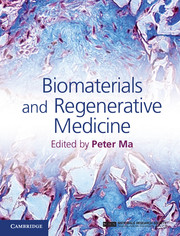Book contents
- Frontmatter
- Contents
- List of contributors
- Preface
- Part I Introduction to stem cells and regenerative medicine
- Part II Porous scaffolds for regenerative medicine
- Part III Hydrogel scaffolds for regenerative medicine
- Part IV Biological factor delivery
- Part V Animal models and clinical applications
- 25 Bone regeneration
- 26 Biomaterials for engineered tendon regeneration
- 27 Advancing articular cartilage repair through tissue engineering: from materials and cells to clinical translation
- 28 Engineering tissue-to-tissue interfaces
- 29 Models of composite bone and soft-tissue limb trauma
- 30 Tooth development and regeneration
- 31 Dentin–pulp tissue engineering and regeneration
- 32 Dental enamel regeneration
- 33 Hair follicle and skin regeneration
- 34 In-vitro blood vessel regeneration
- 35 Stem cells for vascular engineering
- 36 Cardiac tissue regeneration in bioreactors
- 37 Bladder regeneration
- Index
- References
33 - Hair follicle and skin regeneration
from Part V - Animal models and clinical applications
Published online by Cambridge University Press: 05 February 2015
- Frontmatter
- Contents
- List of contributors
- Preface
- Part I Introduction to stem cells and regenerative medicine
- Part II Porous scaffolds for regenerative medicine
- Part III Hydrogel scaffolds for regenerative medicine
- Part IV Biological factor delivery
- Part V Animal models and clinical applications
- 25 Bone regeneration
- 26 Biomaterials for engineered tendon regeneration
- 27 Advancing articular cartilage repair through tissue engineering: from materials and cells to clinical translation
- 28 Engineering tissue-to-tissue interfaces
- 29 Models of composite bone and soft-tissue limb trauma
- 30 Tooth development and regeneration
- 31 Dentin–pulp tissue engineering and regeneration
- 32 Dental enamel regeneration
- 33 Hair follicle and skin regeneration
- 34 In-vitro blood vessel regeneration
- 35 Stem cells for vascular engineering
- 36 Cardiac tissue regeneration in bioreactors
- 37 Bladder regeneration
- Index
- References
Summary
Introduction
The skin is the largest organ in the body and constitutes the interface between the body’s internal organs and its external surroundings. It serves multiple functions, lending thermoregulation, structure, and insulation to the body, and preventing water loss, while also acting as a barrier against external pathogens (Elias and Friend, 1975). The skin also allows an individual to respond to the environment through the nerve endings that sense different stimuli such as touch, pressure, temperature, and pain. These functions are essential for an individual’s survival and are maintained owing to the skin’s ability for regeneration. Much evidence has shown that the presence of stem cells in the epidermis and hair follicles underlies skin regeneration. In this chapter, we will review how skin is maintained under homeostatic conditions and following injury, particularly focussing on the role of stem cells in the hair follicle.
Skin homeostasis
The skin epidermis (i.e. inter-follicular epidermis) is composed of keratinocytes that form stratified squamous epithelium. Throughout an individual’s lifetime, epidermal cells of the skin differentiate and migrate to the superficial layer of the epidermis where they are shed, while being continuously renewed by proliferating cells of the basal layer adjacent to the basement membrane (Figure 33.1) (Mackenzie, 1970; Potten 1974; Watt 2001). Cells in the basal layer of the epidermis are a heterogeneous population in terms of their gene expression (Tani et al., 2000), proliferation rate (Potten and Morris, 1988), and differentiation status (Kaur and Li, 2000). Keratin 14-expressing basal epidermal cells contain long-lived stem cells that contribute to wound healing as well as maintenance of the basal layer of the epidermis (Mascre et al., 2012). However, the specific location of the stem cell niche or markers of stem cells for the inter-follicular epidermis has not yet been identified (Clayton et al., 2007). The properties of epidermal stem cells, and whether stem cells play distinct roles from their progeny in the renewal of skin epidermis, remain unknown.
- Type
- Chapter
- Information
- Biomaterials and Regenerative Medicine , pp. 590 - 602Publisher: Cambridge University PressPrint publication year: 2014



